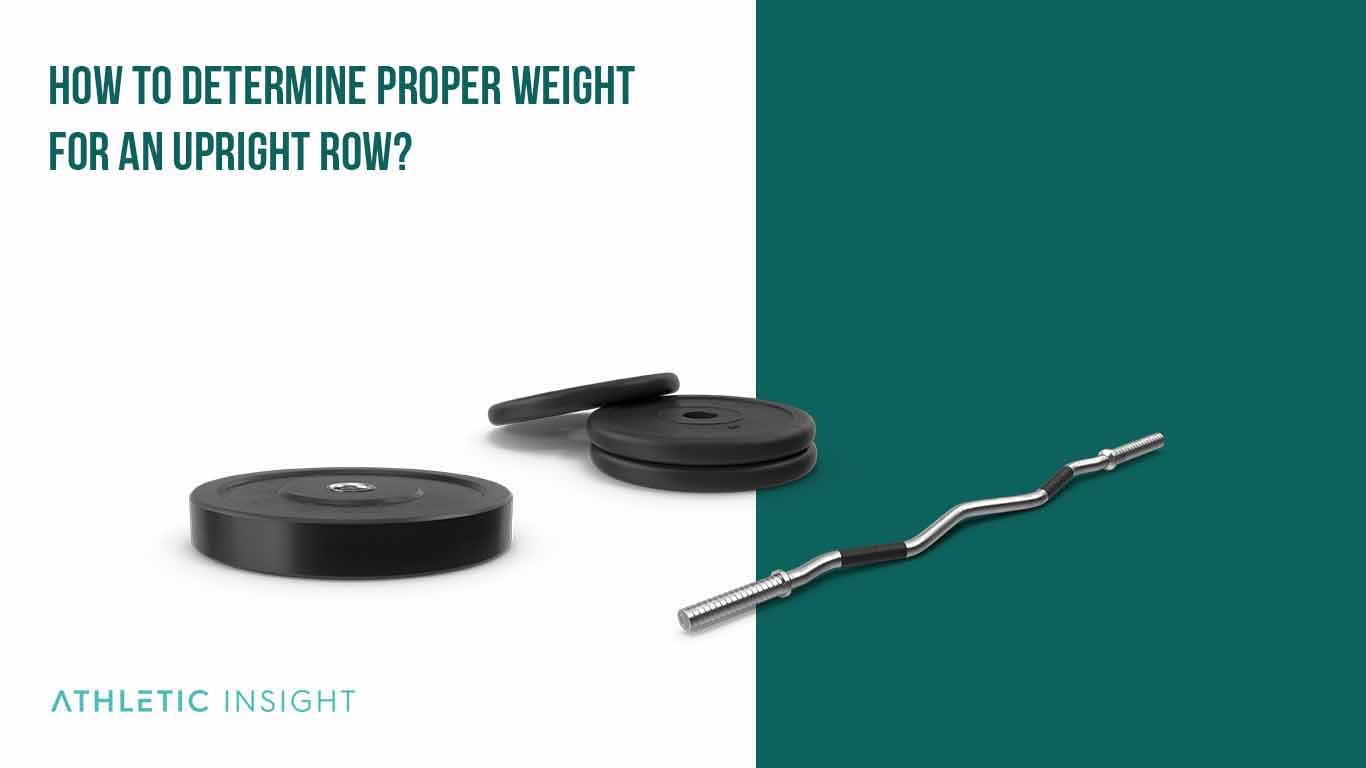The upright row is a compound weight training exercise that effectively targets the deltoids, biceps brachii, trapezius, and core muscles. The upright row exercise is beneficial if you want to build upper body strength and muscle definition. Since the upright row is a beginner-friendly exercise, it is recommended for all athletes, including Strongmen participants, Olympic weightlifters, CrossFit athletes, and bodybuilder performers.
To perform the upright row movement, a weightlifter can use a barbell, dumbbell, bands, weighted plates, a cable system, or any type of weight that can be found. Then, the movement is completed by lifting the aforementioned weight in front of the body by pulling it upwards towards the chest. This movement is done with an overhand grip in a smooth motion.
Naturally, mistakes can happen during any exercise movement, causing injuries such as muscle impingement from internal rotation, upper back muscle strain, or wrist stress. However, you can avoid damage to your muscles and joints by using the proper upright row techniques.
It is critical to keep these common mistakes in mind when you want to master the upright row. This way, you do not repeat incorrect movements. In addition, you can minimize the chances of injury when you take the time to move through the exercise correctly and ensure that you can support the weight accurately.
If your form or grip strength falters, the weight could be too heavy. Try decreasing the amount and repeating the movement for better form control. These common mistakes include; elbows coming above the shoulders, moving through the exercise too quickly, the core is not engaged, rounding the upper back, or the weight being too heavy.
How to Perform Upright Row with Proper Form
The Upright Row is an effective exercise and one of the best shoulder workouts to include in a routine. Knowing the key elements of proper form to execute an upright row will prevent injuries and strain. If, at any time during the upright row, the muscles worked give a sharp pain or discomfort, stop and re-examine your form and weight.
Here’s how to perform the upright row using the proper form.
- Elbows: Keep the elbows level with the shoulders and the forearms parallel to the floor. This positioning will minimize the chances of a shoulder injury.
- Hands: When possible, keep the hand placement wide rather than close, depending on the equipment used. Shoulder-width is the ideal distance to perform an upright row without stress on the wrists.
- Shoulder Blades: Pull the shoulder blades back and down to keep the upper back from rounding during the movement. This way, you minimize the chance of neck or upper back strain.
What Are the Benefits of Doing Upright Rows?
Of course, any exercise routine will benefit the athlete when done correctly and on a schedule. Consequently, upright rows can present several advantages for anyone looking to improve their workout routine.

So, what does an upright row work during movement? Individuals may see some or many of these benefits.
- Increases shoulder strength. The deltoid muscles will become stronger and support more weight for other exercises with proper form.
- Gives defined and sculpted shoulders and traps. Doing exercises that isolate specific muscle groups, like upright rows, will help give you a sculpted look at the shoulders and trapezius muscles.
- Helps you lose weight. Any time you perform an exercise, your body will burn calories for energy. This compound movement ensures multiple muscle groups are activated, burning more calories and helping to lose weight.
- Improves shoulder stability and mobility. As the deltoid muscles grow and strengthen, they can support more weight and have improved mobility and flexibility. In addition, this element aids in performing other exercises that require shoulder movement.
- Improves your posture. Upright rows help develop the core and upper back muscles. Together, they support the spine to help maintain correct posture.
- Improves your stamina. By performing many exercises that require arm and shoulder movements, your body builds up stamina and endurance to sustain heavier weight for longer reps over time.
What Are the Mistakes for Upright Row Form?
No one is perfect, especially when learning a new exercise. However, it is critical that you know some popular mistakes with the upright row form so you can minimize the chances of injuring your shoulders or hurting other muscle groups.
- Tensing the shoulders
- Flaring the elbows
- Rolling the shoulders
1. Tensing the Shoulders
It is easy to tense the shoulders when pulling the barbell up, but this action can put too much stress on your deltoids and erector spinae. Also, avoid bringing the shoulders up to the ears as you raise the arms, or you may risk straining the upright row muscles improperly.
2. Flaring the Elbows
Another frequent mistake during this exercise is flaring the elbows. Two ways will create unnecessary wrist strain. One instance has the elbows pointed to the ceiling while the wrists are down towards the chest. Another improper form mistake is when they flare out front from the body.
3. Rolling the Shoulders Forward
It can be easy to falter from good upright row form when the weight is too heavy on the barbell. If you find that your shoulders begin to round forward during the movement, pull the shoulder blades back and down. You may also have to decrease the weight until you perfect the form.
How to Determine Proper Weight for an Upright Row?
Part of ensuring you do not hurt yourself is determining the proper weight for the movement. For example, if the weight is too heavy, you may not hold the barbell level, or the elbows may flare out during the repetition. .

The weight should be lighter than a regular pulling movement as you isolate your deltoids as one of the primary muscle groups.
Upright shoulder rows should consist of weight that is light enough to perform high repetitions, rather than heavy weight with low reps. Three to five sets of 12 to 15 repetitions are ideal for upright shoulder row exercises.
Which Muscles Are Involved While Performing an Upright Row?
Pulling exercises like upright shoulder rows require many muscle groups working together simultaneously. The muscles that this exercise targets aid in many daily activities.
- Deltoids
- Trapezius
- Biceps
- Core
Deltoids
The deltoid muscles reside within the shoulder and consist of three parts (known as the anterior, lateral, and posterior). These three parts provide complete shoulder support and help to effectively move the arm forward, backward, and side to side.
Trapezius
The traps help support shoulder blade movement, shoulder stability and allow you to lift heavy loads with ease. These upper back muscles start as the base of the neck, moving downward through the mid-back and extending to the shoulder area. Also known as traps, they support the head, neck, and shoulder movement, stabilize the spine, and aid posture. If you want to improve your dumbbell press, regular upright rows can help.
Biceps
This primary upper arm muscle ensures the shoulder and elbow work together. Biceps help support the movement of the arm while pushing or pulling weight. Anytime you want to extend and retract the arm, such as in hammer curls, upright row movements will prove beneficial.
Core
Core muscles keep the entire body strong and in line. As a result, they promote good posture and allow torso movement while minimizing back injury. In addition, a strong core will aid in keeping your balance while doing other actions like the snatch and grab.
How to Do an Upright Row?
Working through these steps will ensure proper form for the maximum benefit if you want to dominate the upright row.

- Place your feet shoulder-width apart. This position will ensure the proper balance during the movement. If the feet are too close together, you may be unsteady when raising heavy weights on a barbell.
- Allow the barbell to hang in front of you at the length of your arms. Here, you can set your body in the proper position for the exercise.
- Place the palms facing your body. This exercise requires an overhand grip for correct movement.
- Put your hands in line with your thighs. The hand position should be shoulder-width apart to minimize any wrist strain during upright rows. Although other variations require close grip, the standard upright row uses shoulder-width hand placement.
- Breathe in and tighten your abs. Inhaling and engaging the core muscles will ensure a stable back before the pull motion.
- Maintain a straight back, a high chest, and a forward gaze. Keep the body facing forward without rolling the shoulders inward. Look ahead and keep the chin up to reduce any stress on the neck muscles and maintain a straight back.
- Exhale and pull the barbell (toward the chin). Next, exhale while you begin to raise the barbell to the chest, just under the chin. Remember to keep the forearms level with the floor at all times.
- Keep the bar close and lead with the elbows. Ensure that the bar is close to the body so it grazes the abdominals and chest. Again, lead the movement with the elbows rather than the shoulders or wrists.
- Do not raise your arms higher than parallel with your shoulders. Instead, keep the arms parallel with the floor and stop when you reach shoulder height. Movement above the shoulders invites unnecessary injury.
- Pause at the top of the lift. Stopping and pausing provide isometric stress on the muscles for optimal strength and growth. This stage helps ensure you do not rush through the exercise and rely on momentum.
- Inhale, lower the barbell back to its starting position. Finally, inhale while lowering the barbell in a slow, controlled motion, and let it hang down in front of the body.
What Are the Upright Row Variations?
There are several variations and alternatives to an upright row, although many use the same principles for proper form and execution.
Some modifications to an upright row include alternative hand placement or different equipment, like using weight plates for a plate upright row.
- Narrow Upright Row: This variation requires the hands to sit close together on the barbell during execution. This positioning can increase the range of motion and joint flexibility.
- Clean Grip Upright Row: This movement mimics the clean exercise and is completed in separate stages.
- Snatch Grip Upright Row: This variation begins with the barbell resting on the floor, so you have to snatch it up to execute the movement.
- Cable/Band Upright Row: This alternative to the upright row uses the cable machine or weight bands to provide resistance throughout the movement rather than weights on a barbell.
- Dumbbell Upright Row: This movement uses dumbbells rather than a barbell with weights to perform the exercise. This variation helps to focus on each side, so the dominant arm is not overcompensating during the movement.
What Are the Shoulder Muscle Exercises with Upright Row?
Many gym-goers will follow various workout routines. While some target the shoulders directly, like the upright row for shoulder mobility, others incorporate exercises for the entire upper body.
One way to build strong deltoid muscles is by following a regime. Here’s our suggestion.
- Barbell Upright Rows
- Overhead Rows
- Bench Press
- Push-Ups
This recommended workout program will exercise your shoulder muscles with the upright row, but you can tailor and alternate this regime judging on what works best shoulder exercises for you.
What Are the Upright Row Related Facts?
Mr. Olympia Lee Haney invented the Behind-the-Back Upright Rows. The backward exercise of an upright row targets muscles that are lower down on the back and the upper traps that do not activate as much with forward rows.
Does Upright Row Affect the Hormones?
Any exercise can affect hormones in the body, but compound movements like the upright row shoulders exercises engage several main muscle groups that encourage testosterone and growth hormone.
Muscle fibers and tissue growth increase when these hormones appear during an exercise routine. Therefore, the more frequently you use compound exercises, the more you activate these hormones to increase muscle mass.
Does Upright Row Affect the Mood?
Regular exercise will help improve your mood and release tension and stress. Compound movements like the upright row can increase self-esteem and a better sense of overall well-being.
So, what muscles do standing rows work for a better self-image? It helps sculpt the arms and shoulders for a more chiseled look.
Is Upright Row Practiced Within CrossFit?
Yes, upright rows are standard in CrossFit routines. This exercise helps build strength and stability that aid in other movements, including high pulls or power cleans.
In addition, athletes who regularly perform upright rows can notice more endurance and stamina for their workout routine.
Is Upright Row a Military Movement?
Yes, the upright row is a recognizable military exercises that many individuals perform to strengthen the shoulders, upper back, and core.
Is Upright Row Dangerous?
No, the upright row is not dangerous if an individual follows proper form during the exercise. However, there is a risk of shoulder injury due to shoulder impingement.
Is Upright Row Essential?
Yes, the upright row is essential for anyone looking to build strong shoulders, back, and core. In addition, these major muscle groups are vital for other exercises, including the bench press and upright row dumbbell movements.
Is Upright Row a Compound Exercise?
Yes, the upright row is a compound exercise because it engages multiple muscle groups simultaneously. However, athletes will find performing the upright row for the back, shoulders, and biceps muscles extremely effective.



